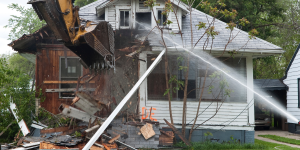Bare Demolition Equipment Essentials for Efficient Work
Introduction

Bare Demolition in Australia
In Australia’s construction and site redevelopment, bare demolition stands out as a distinctive and meticulous process. Just as surgeons depend on precision tools for intricate operations, successful bare demolition hinges on specialized equipment. This blog discusses the equipment essentials for efficient and safe demolition.
Bare Demolition Techniques and Best Practices
Bare demolition is much more nuanced than it may appear on the surface. It isn’t just about taking down structures; it’s a delicate dance of safety, efficiency, and expertise. With the right approach, a demolition job can be executed seamlessly, minimizing risks and maximizing productivity.
Below are some vital techniques and best practices to follow:
1. Surveying the Site
Before starting any demolition job, conducting a comprehensive survey of the site is imperative. This involves:
- Understanding the materials used in construction to determine the required equipment and techniques.
- Identifying hazardous materials, such as asbestos, can be harmful when disturbed. Special care must ensure these materials are managed and disposed of correctly.
- Planning waste management. The demolition process will produce a significant amount of waste. Planning its disposal in an environmentally-friendly way is essential.
2. Safe Distancing
The importance of safety during demolition can’t be overstated. This involves:
- Ensuring both the public and the workers are at a safe distance from potential risks. This might mean evacuating nearby structures or cordoning off areas.
- Erecting barriers or fences to delineate the active demolition area. Signage can also help inform the public of the ongoing work and associated dangers.
3. Equipment Check
The machinery used in bare demolition is powerful so any malfunction can lead to severe consequences. Hence:
- Equipment should be inspected regularly for signs of wear and tear.
- Ensure all operators are trained adequately on the specific machinery they’re handling. A skilled operator can make a significant difference in safety and efficiency.
- Have standby equipment or parts available. This can reduce downtime in the event of a malfunction and ensure that the project stays on schedule.
4. Training and Expertise
The expertise of the demolition team is a critical component:
- Workers should undergo regular training to stay updated on the latest safety protocols and operating procedures.
- An experienced team can anticipate challenges and strategize accordingly, reducing potential hazards and ensuring a smoother process.
5. Environmental Considerations
A demolition job has environmental implications:
- Dust and debris need to be managed to prevent air pollution. Water sprays or other dust control measures can be employed to keep the dust down.
- Noise pollution is also a concern. Scheduling demolition during suitable hours and using noise-reducing equipment can help mitigate this issue.
Bare Demolition Safety Measures Every Worker Should Know
Safety always comes first, especially in a field as challenging as demolition. Here are the necessary measures every worker should be aware of:
- Proper Training: Ensure every worker is adequately trained to handle the machinery.
- Protective Gear: Helmets, gloves, protective eyewear, and safety boots are necessary.
- Stay Updated: Regular safety briefings should be conducted to update the crew about potential risks.
Bare Demolition Equipment Essentials
Manual Tools for Initial Work
Though heavy machinery often gets the spotlight, many manual tools are essential for the initial stages of a demolition project:
- Sledgehammers: Ideal for breaking through walls and concrete.
- Pry Bars: Useful for removing nails and prying up floorboards.
- Chisels and Handheld Jackhammers: Perfect for more intricate tasks requiring precision.
Heavy Machinery for Large Scale Operations
When the scale of demolition grows, heavy machinery becomes indispensable:
- Bulldozers: These are versatile machines, great for simultaneously pushing large amounts of debris.
- Excavators: Equipped with a demolition arm, they can reach high structures and are ideal for projects like building demolitions.
- Wrecking Balls: A classic in the demolition industry, they’re used to destroy concrete structures.
Bare Demolition and the Environment: Minimizing Impact
A responsible demolition process also means considering the environmental impact. Ensuring environmentally-friendly demolition practices is about reducing the carbon footprint and safeguarding the environment for future generations. Let’s dive deeper into the points mentioned:
Recycling Materials
Concrete: Instead of sending old concrete to a landfill, it can be crushed and reused as aggregate for new concrete or as base materials.
- Metal: Metals, especially steel and aluminum, can be melted down and remolded into new products, minimizing the need for virgin materials.
- Wood: While not all wood from demolition can be recycled due to treatments, paint, or deterioration, uncontaminated wood can be chipped.
Dust Control
Demolition activities can generate large amounts of dust, which is not only a health hazard to workers but can also impact local air quality and ecosystems.
- Water Sprayers: These can be strategically placed to dampen the dust.
- Dust Suppressants: Apart from water, chemical suppressants can be sprayed on the demolition site.
Waste Management
Responsible waste management ensures that the materials from a demolition site are handled, processed, and disposed of in an environmentally friendly manner. Before disposal, waste materials should be separated into different categories, like metals, plastics, and organic materials. This facilitates more efficient recycling and reduces the contamination of recyclable materials.
Challenges Faced in Bare Demolition
The path of demolition is fraught with its own set of challenges. While having the right equipment is crucial, understanding these challenges can prepare a team better:
Structural Integrity and Unforeseen Issues
Often, the structures slated for demolition have deteriorated extensively, posing risks of unexpected collapses. Moreover, blueprints may only sometimes highlight post-construction modifications, leading to unpredicted challenges.
- Asbestos and Hazardous Materials: Many old structures have materials that may be harmful if inhaled or touched, like asbestos. Special equipment and care are necessary to handle these materials.
- Utility Lines: Hidden electrical, water, or gas lines pose significant risks. Accidentally damaging them can lead to accidents or further infrastructure damage.
Cost Efficiency in Bare Demolition
While the primary focus is safety and efficiency, cost remains a significant concern in demolition projects.
- Renting vs. Buying Equipment: Depending on the frequency and scale of projects, companies must decide whether it’s more cost-effective to rent or buy heavy machinery.
- Manpower Training: Regularly updating the crew’s skills can incur costs, but it’s a necessary investment for safety and efficiency.
Innovations in Bare Demolition Equipment
As technology advances, so does the machinery in demolition. Keeping abreast of these innovations can lead to quicker and safer operations:
- Remote-Controlled Machinery: Allows operators to handle machinery from a distance, ensuring safety in precarious situations.
- Eco-Friendly Machinery: With the world moving towards sustainable practices, machinery that produces fewer emissions or operates on alternative fuels is gaining traction.
- Advanced Sensors and AI: Some modern equipment has sensors to detect structural weaknesses or hazardous materials, making the process safer and more efficient.
Preparing the Site Post-Demolition
After the demolition process, preparing the site for its next phase is crucial, whether it’s reconstruction or landscaping:
- Soil Testing: Before any new construction, the soil must be tested for its capacity to bear weight and any potential contaminants.
- Clearing Debris: A thorough clearing ensures no hazardous materials or rubble impede the next development phase.
- Recycling Rubble: The debris from a demolition site can often be recycled into aggregate for construction or as a base for roads.
The Importance of Hiring a Professional Demolition Team

Embarking on a bare demolition project isn’t just about tearing down structures; it’s a meticulous task requiring expertise and precision. Here’s why hiring a professional demolition team is paramount:
Expertise and Experience
Professional teams come with years of experience, ensuring the demolition process is carried out smoothly. Their knowledge of different structures and materials involved means they can anticipate challenges and mitigate risks.
Safety First
A professional team prioritizes the safety of its workers and the surrounding environment. They’re trained to handle emergencies, and their protocols ensure minimal risks to public safety and nearby structures.
Efficient and Timely Completion
Time is often of the essence in construction and redevelopment projects. With a professional team, project timelines are more predictable. Their efficiency ensures that subsequent development phases can commence without unnecessary delays.
Regulatory Compliance
Demolition projects often have many regulations, from environmental considerations to building codes. Professional teams are well-versed in these regulations and ensure compliance, saving you from potential legal complications.
Conclusion
Bare demolition isn’t just about tearing down; it’s about using the right equipment, ensuring safety, and being environmentally responsible. A demolition job can be efficient, safe, and eco-friendly with the proper techniques, safety measures, and equipment.
In understanding the intricacies of demolition and the need for professionalism, Rapid Demolition emerges as a trusted partner. With years of experience, state-of-the-art equipment, and a team of seasoned professionals, we ensure your demolition project is in safe hands. Our reputation is built on safety, efficiency, and customer satisfaction pillars. If you’re considering a demolition project, whether big or small, reach out to us. Let Rapid Demolition help pave the way for your next construction milestone.
